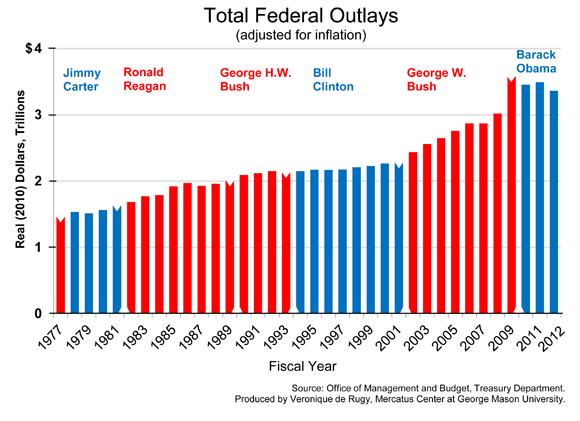The Only Budget Numbers Worth Talking About are 3.5, 3.6, and 3.9

The GOP House has released its budget plan. Go here to read and download the latest version of The Path to Prosperity, authored by Rep. Paul Ryan's crew.
The most important number in any given federal budget document is the amount it proposes to spend in the coming fiscal year (typically this is done in Summary Table 1 in a budget document). The government can't control revenue (collected taxes) and it certainly can't control the ultimate size of the economy (GDP) or predict how much the government will be spending 10 years down the road (it typically undercounts that amount). The one thing it can actually lay on the table is a single number on the spending side for the coming year.
The GOP budget for fiscal year 2014, which starts on October 1, 2013, proposes spending a total of $3.5 trillion, which is roughly what we're on track to spend this year. The latest Congressional Budget Office Budget and Economic Outlook document, released in February, says the feds will spend $3.6 trillion in 2014 (the CBO is required to run numbers based on existing laws). President Obama's budget plan for last year assumed we'd spend $3.9 trillion in 2014. He will release his budget plan in early April and it is highly unlikely he will suggest spending more than $3.9 trillion. Indeed, the feds will end up spending about $200 billion less in 2013 than he suggested in last year's plan.

The Senate Democrats, who have spent the better part of the last four years not even producing a budget much less passing one, are supposed to release their budget plan as early as tomorrow. It's likely that the proposal will be within the range set out by the three documents already in circulation. So we can anticipate a budget battle that will focus on whether we spend between $3.5 trillion and $3.9 trillion in 2014. That's not a small difference, by any stretch, but it's also far smaller than the varying amounts that the three plans project for 10 years out. The GOP plan says the feds will spend $5 trillion in 2023, the CBO figures $5.9 trillion, and Obama projects $5.8 trillion (for 2022; all figures are in current dollars).
The GOP plan assumes that Obamacare will not take place, which is highly unlikely (however desirable that might be). It is unclear about defense spending, the largest part of the discretionary budget, other than to say that defense - apparently including money for war on terror-related operations - will get $560 billion in 2014 and "over $6 trillion to defend our nation" over the coming decade. While it proposes reducing the top marginal income tax rate to 25 percent, it assumes no changes in tax revenue vis a vis current policy. The budget plan doesn't talk about changing Social Security (both Congress and the president are asked to submit reform plans for consideration) and its major proposed fix for Medicare - "premium-support" and the choice between competing private plans and traditional Medicare - only starts in 2024. If offering a choice makes sense in 2024, you've got to wonder why it doesn't make sense in 2014.
All of that sort of stuff is very interesting and certainly it's worth thinking about the differences in underlying philosophy that would create a variance of almost $1 trillion a year in 2023. But as we await the Senate's plan - the veritable Chinese Democracy or Detox of budget documents! - and the president's, the only real question is whether we're going to basically keep spending constant, as we've done for the past three years (see chart above). More than anything else, that would Barack Obama's presidential term as truly historic. Or are we going to goose it up by as much as $400 billion a year? And if the latter, what in the world could that possibly be spent on that would pass the least-demanding smell test?


Show Comments (52)